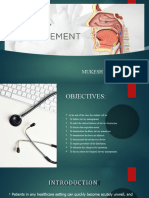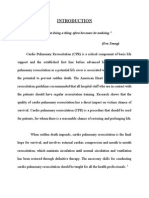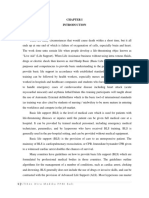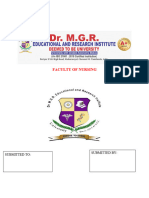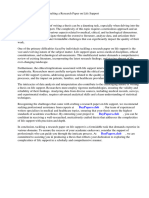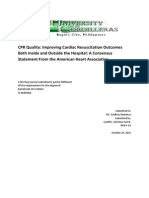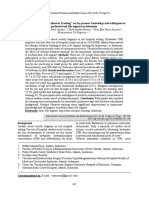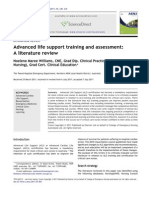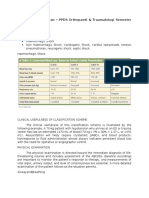Professional Documents
Culture Documents
Evaluate The Effectiveness of Structured Teaching Programme Regarding Basic Life Support Among Fire and Rescue Service Personnel in A Selected Fire Station
Evaluate The Effectiveness of Structured Teaching Programme Regarding Basic Life Support Among Fire and Rescue Service Personnel in A Selected Fire Station
Original Title
Copyright
Available Formats
Share this document
Did you find this document useful?
Is this content inappropriate?
Report this DocumentCopyright:
Available Formats
Evaluate The Effectiveness of Structured Teaching Programme Regarding Basic Life Support Among Fire and Rescue Service Personnel in A Selected Fire Station
Evaluate The Effectiveness of Structured Teaching Programme Regarding Basic Life Support Among Fire and Rescue Service Personnel in A Selected Fire Station
Copyright:
Available Formats
Volume 9, Issue 4, April – 2024 International Journal of Innovative Science and Research Technology
ISSN No:-2456-2165 https://doi.org/10.38124/ijisrt/IJISRT24APR350
Evaluate the Effectiveness of Structured Teaching
Programme regarding Basic Life Support among Fire
and Rescue Service Personnel in a selected fire station
A. Priya Mary Stella
P.K. Das College of Nursing
Abstract:- When sophisticated medical care is not I. INTRODUCTION
available, individuals might receive a specific degree of
pre-hospital care known as "Basic Life Support." "We Serve To Save”
understanding basic life support in an emergency can save
lives. The statement of the problem is a study to evaluate There has been an accident! What shall we do? He has
the effectiveness of Structured Teaching Programme fallen and bleeding severely from the head. His face is blue
regarding Basic Life Support among Fire and Rescue and I'm sure he has stopped breathing. He is cold and clammy,
Service Personnel in a selected fire station. and I couldn't feel his pulse, he may die! What next?
The objectives of the study were; Every day, somewhere, somebody repeats hundreds of si
To assess the existing knowledge regarding Basic Life milar words, such as "emergency," "disaster," "gloom," and "d
Support among the Fire and Rescue Service Personnel. espondency."that needs to be carried out? person who understa
To determine the Effectiveness of Structured Teaching nds the fundamentals of first aid should typically be able to fol
Programme regarding Basic Life Support among Fire low a clear-
and Rescue Service Personnel. cut path.There is no need to fear; there are methods that can pr
To determine the association between knowledge event someone from passing away, such as cardiopulmonary
regarding Basic Life Support with their selected resuscitation.
demographic variables (Age, Educational Status,
Designation, Working Experience, Previous Knowledge In order to deliver oxygen to the tissues, breathing and
and Source of Previous Knowledge) heart activity are necessary. One of the primary organs
affected by oxygen starvation is the brain, which can begin to
The conceptual framework adopted for the present study show signs of damage after four minutes and become
was based on Daniel Stuffle Beam's CIPP Model (1971). irreversibly damaged after approximately seven minutes. The
A Quasi-Experimental study was conducted in the heart very swiftly loses its capacity to beat normally.
Fire Station at Coimbatore among 60 Fire and Rescue Following a cardiac arrest, successful CPR allows enough
Service Personnel. The samples were selected randomly by oxygen to reach the brain, delaying brain death and keeps the
adopting the lottery method. The instrument consisted of heart receptive to defibrillation attempts.
structured self administered questionnaire to assess the
knowledge regarding Basic Life Support. The content If CPR is performed fifteen minutes after collapse, it is
validity of the tool was 0.9 and reliability was 0.9 which nearly never successful since irreversible brain damage has
was highly reliable. Structured Teaching Programme was possibly already happened. The general population is
carried out by Lecture cum discussion with demonstration frequently instructed in CPR since they can be the only ones
by using a CPR manikin. After 7 days the same tool was there in the vital few minutes until medical assistance arrives.
used for post test. The results show that the’t’ value of
knowledge was 24.75. It was significant at (p<0.001). The Basic support systems of the body are circulation
Hence the provided Structured Teaching Programme was and respiration, for without there functions life cannot be
very effective and has made way for the Fire and Rescue sustained. To effectively support these systems, Basic Life
Service Personnel to achieve their motto of "We Serve to Support (BLS) procedures have been designed to intervene
Save". when the systems are assessed to need intervention. Basic life
support is a specific level of pre-hospital medical care
Keywords:- Evaluate, Effectiveness, Structured Teaching provided by persons, in the absence of advanced medical care.
Programme, Basic Life Support, Fire and Rescue Service Basic life support consists of a number of life saving
Personnel.
IJISRT24APR350 www.ijisrt.com 234
Volume 9, Issue 4, April – 2024 International Journal of Innovative Science and Research Technology
ISSN No:-2456-2165 https://doi.org/10.38124/ijisrt/IJISRT24APR350
techniques focused on the "ABC's Airway, Breathing, save thousands of lives during rescue operations as well as
Circulation of pre hospital emergency care. transporting the victims to the hospitals.
When a patient is declared to be in cardiac arrest, time Therefore Basic Life Support is viewed as a measure to
matters: if nothing decisive is done within four to six minutes, support a patient until health care providers trained in
the patient will sustain permanent brain damage. If the patient advanced life support techniques can provide more advanced
is to have a chance of survival, immediate intervention is strategies to facilitate the victim's survival.
required. Deadly consequences are frequently avoided with
prompt and efficient CPR. ACLS stands for Advanced Cardiac Therefore the researcher has considered the fire and
Life Support, while BLS is the basic life support. rescue service personnel as a bridge between the victim and
the health care provider and has selected them as the sample.
The rapidity and competence are more important in Basic
Life Support, as the components of CPR are given without the So all the above stated literatures and statistics of the
need for extra equipment. The major goal of this therapy is to lives lost in rescue calls motivated the researcher to conduct a
get the blood flowing again, with oxygen, to the brain. study to evaluate the effectiveness of Structured Teaching
Programme regarding Basic Life Support among the Fire and
Adults on Basic Life Support receive 30% of their Rescue Service personnel.
normal cardiac output, which is sufficient blood flow for
physiological needs. It is suggested that non-professionals Problem Statement
require more extensive and improved training because fewer A Study to evaluate the effectiveness of Structured
than one-third of patients who experience an out-of-hospital Teaching Programme regarding Basic Life Support among
cardiac arrest receive CPR. An estimated 75% of cases of Fire and Rescue Service Personnel in a selected fire station.
sudden cardiac arrest occur at home, according to the Heart
Association. Objectives of the Study
To see the existing knowledge regarding Basic Life Suppot
In films and television shows, CPR is frequently shown among the Fire and Rescue Service Personnel
as a very successful method of resuscitation for someone who To determine the Effectiveness of Structured Teaching
is unconscious and lacks circulation. According to Hallstrom Programme regarding Basic Life Support among Fire and
(1996), 75% of CPR attempts in television programmes were Rescue Service Personnel
successful. Therefore, laypeople can learn BLS after taking a To determine the association between knowledge
quick course, and it also mentions that certification is required regarding Basic Life Support with their selected
for police and fire personnel. demographic variables (Age, Educational Stanie, Denton,
Working Experience, Previous Knowledge and Source of
The motto of the Tamil Nadu Fire and Rescue Service Previous Knowledge),
Department is "We Serve To Save" and strive to save life and
property, to rescue people affected by floods, earthquakes or Hypotheses
other natural calamities and to rush the sick and injured to
hospital. Besides fighting fire and helping to prevent fires, it H1: The mean post score of knowledge will be
also includes emergency relief and rescue measures to victims significantly higher than the mean pre score of knowledge
not only of fire, but also all types of natural and other regarding Basis Life Support among Fire and Rescue
calamities like floods, cyclones, landslides, building collapses, Service Personnel
explosive accidents, railway accident, major disasters etc. H2 :There will be a significant association between the
knowledge regarding Basic Life Support among Fire and
The cardiac and respiratory arrest usually occurs due Rescue Service Personnel with their selected demographic
smoke inhalation, toxic gas inhalation, drowning, obstruction variables (Age, Educational Status, Designation, Working
from foreign bodies and penetrating trauma, in all these Experience, Previous Knowledge and Source of Previous
conditions the Fire and Rescue Service Personnel has a greater Knowledge),
exposure in the golden hours of the victims survival and also
in some situations the knowledge on basic life support can II. REVIEW OF LITERATURE
helps them to save the life of even their colleagues as quoted
above. At the time of the study an extensive review of related
literature was done, several articles were discussed about the
With the primary motto of the Fire and Rescue Service is various teaching techniques and there was no study particular
to "Save Life" the researcher feels that if they have adequate to the selected population of the study, but few of the
knowledge regarding Basic Life Support, they will be able to
IJISRT24APR350 www.ijisrt.com 235
Volume 9, Issue 4, April – 2024 International Journal of Innovative Science and Research Technology
ISSN No:-2456-2165 https://doi.org/10.38124/ijisrt/IJISRT24APR350
following are relevant and they are organized into the Sampling Technique
following areas. The samples were selected for this study by adopting
Studies related to Fire and Rescue Service. simple random sampling technique Lottery method was used
Studies related to Effectiveness of Bystander CPR to select 60 samples from the total population. There were
Training. totally 80 firemen in Coimbatore Fire Station, all 80 fall in the
Studies related to Knowledge, Attitude and Skill of CPR. inclusion criteria. A name list of all 80 fire men was made
Studies related to Effectiveness of Bystander CPR. after getting the willingness from the firemen. From the name
Studies related to Effect of CPR on Cardiac Arrest. list lots were prepared and 60 lots were taken without
Studies related to CPR in Specific Conditions. replacement. The names in the lots were selected as the
sample for the study.
III. METHODOLOGY
Development of Instrument
Research Approach After in depth review of literature and consulting with
The Research approach used for this study is a experts, the research instrument was developed in English. A
quantitative approach without control group, by manipulating linguist with expertise in Tamil translated it. The Structured
the variables to assess the effectiveness of the structured self- administered questionnaire was utilized as an instrument
Teaching programme regarding Basic Life Support. to assess firefighters’ knowledge about Basic Life Support.
Research Design Description of the Tool
A quasi experimental design has been chosen for this The instrument consists 2 parts;
study. One group pre-test and post-test design without control
group and observations has been made before and after the Part-1:
teaching programme. Consisted of demographic data of the Fire and Rescue
Service Personnel, (Age, Educational Status, Designation,
Hence the researcher has chosen the quasi experimental Working Experience, Previous Knowledge and Source of
design to evaluate the effectiveness of teaching programme Previous Knowledge regarding Basic Life Support).
among Fire and Rescue Service Personnel regarding Basic
Life Support. Part-II:
The Self Administered Questionnaire consists of 50
Variables Multiple Choice Questions to assess the Knowledge regarding
Independent Variable -Structured Teaching Programme Basic Life Support among the Firemen in the following areas:
regarding Basic Life Support. Basic concepts of CPR -2 questions
Dependent Variable-Knowledge regarding Basic Life Airway -8 questions
Support Breathing -10 questions
Foreign Body Obstruction- 5 questions
Setting of the Study Circulation -18 questions
The study was conducted in the Tamilnadu Fire and Recovery position -4 questions
Rescue Service Department Head Office which is situated Complications -2 questions
opposite to the Coimbatore Railway Station. Legislation -1 question
Criteria for Sample Selection Structured Teaching Programme
It was developed by reviewing the literature and
Inclusion Criteria obtaining experts opinion. The teaching was held for 1 hour
duration comprised the overall objectives, specific objectives,
Content, Teachers Learners activity, summary and conclusion.
The firemen who are able to understand Tamil or English
The firemen those who are present at the time of the study
The content area of the Structured Teaching Programme
included definition, levels of CPR, The ABC's of
Exclusion Criteria
Resuscitation, Assessing Unresponsiveness, Maintenance of
The firemen who are not willing to participate in the study.
patent airway, Breathing assessment, Mouth to mouth
The firemen who underwent training previously regarding
respiration, Management of foreign body obstruction,
Basic Life Support
Assessment of circulation, Chest compressions, Recovery
Position, Reassessment, Complication and Legal
Consideration. The method of teaching program was given by
lecture cum discussion and demonstration. The CPR manikin
was used as the Audio Visual Aid.
IJISRT24APR350 www.ijisrt.com 236
Volume 9, Issue 4, April – 2024 International Journal of Innovative Science and Research Technology
ISSN No:-2456-2165 https://doi.org/10.38124/ijisrt/IJISRT24APR350
Scoring Procedure firemen in each group and demonstration of the procedure was
Part II: Regarding the multiple choice questions on done. Booklets on Basic Life Support were issued to the study
knowledge regarding Basic Life Support the maximum samples. After giving Structured Teaching Programme and
possible score was 50 and a score of one mark was given for seven days interval, again same self administered
every correct answer and a score of Zero was given for every questionnaire was given to the samples for assessing post- test.
wrong answer. The same duration was given to study samples.
For the purpose of the study, the total score was Plan for Data Analysis
classified as follows: The demographic variables were organized by using
Adequate Knowledge ≥75% descriptive measures (Frequency and Percentage). The
Moderately Adequate Knowledge 51%-74% knowledge was assessed by using descriptive measures like
Inadequate Knowledge <50% (Mean, Standard deviation and mean difference).
Validity and Reliability The effectiveness of the structured Teaching programme
was assessed by using paired 't' test.
Content Validity of the Tool
The content validity of the self administered The association between the knowledge with their
questionnaire has been checked and evaluated by experts selected demographic variables were analyzed by using the
including 5 nursing experts and 2 medical experts, who inferential statistics (chi-square).
validated the tool regarding the adequacy of the content and
the sequence in framing of questions and based on their valid Protection of Human Rights
suggestions reframing of the instrument was done. The items The Study was conducted after the approval of the
were rated by the experts on four-point scale. The Content Dissertation Committee. The nature and purpose of study was
Validity Index for the total instrument was 0.9 which indicates explained to the Divisional Fire Officer and permission was
good content validity. obtained. Oral consent was obtained from the samples before
starting the data collection in order to get their full
Reliability of the Tool cooperation. Assurance was given to the samples that
The tool was administered to 10 samples representing the anonymity of each individual will be strictly maintained.
characteristics of the population, the split half technique was
used to calculate the correlation coefficient, for this approach IV. MAJOR STUDY FINDINGS
items on the questionnaire were split into two groups and
scored independently, the split was done by using odd items Among Fire and Rescue service Personnel, majority fall in
versus even items, the correlation coefficient was calculated. the age group of 25-35 years, and had an educational level
The reliability estimate for the questionnaire was estimated by of higher secondary, and equally were in the grades of
using Spearman-Brown Prophecy Formula. The reliability junior and senior firemen and a work experience of more
estimate of the tool was 0.9. than 5 years and had no previous knowledge regarding
Basic Life Support and the source of previous knowledge
Pilot Study gain was from mass media and none of them gained in
The researcher conducted pilot study among 10 firemen their training period.
working at Kavundamplayan fire station after obtaining Regarding the knowledge on Basic Life Support among
permission from the District Fire Officer. The pilot study Fire and Rescue Service Personnel, greater strength of
revealed that the study was feasible. Data were analyzed to them had inadequate knowledge in Pre-Test and more than
find the suitability of the statistical methods. half of them acquired adequate knowledge in Post-Test.
With regard to effectiveness of Structured Teaching
Data Collection Procedure Programme regarding Basic Life Support among Fire and
The data collection procedures were done for a period of Rescue Service, the result showed that the Structured
9 days for pre-test, Smactured Teaching Programme and post- Teaching Programme was effective among Fire and
test. The permission was obtained from the Divisional Fire Rescue Service Personnel between Pre-Test and Post-Test
Officer, Coimbatore. The samples were informed by the of knowledge. The obtained 't' value of knowledge was
investigator about the purpose and nature of the study and 25.75 which was significant at (p<0.001) level.
their oral consent was obtained. The structured self With regard to association between knowledge on Basic
administered questionnaire was given to the study samples to Life Support among Fire and Rescue Service Personnel
assess the pre-test. It took 40-45 minutes to collect data from with their selected Demographic variables. The results
the samples. On the next day structured teaching program was revealed that there was a significant association between
given to the firemen. For 20 minutes lecture was given to all knowledge regarding Basic Life Support and previous
the firemen, then they were divided into 3 groups of 20 knowledge among Fire and Rescue Service Personnel and
IJISRT24APR350 www.ijisrt.com 237
Volume 9, Issue 4, April – 2024 International Journal of Innovative Science and Research Technology
ISSN No:-2456-2165 https://doi.org/10.38124/ijisrt/IJISRT24APR350
there was no significant association between the [12]. Lois White. (2005). Foundations of Basic Nursing, (2nd
knowledge on Basic Life Support and the age in years, ed) USA; Jhomson Publications. 640-647.
educational status, designation and working experience [13]. Luckmann, L. Soreson (2000), Medical Surgical
and source of previous knowledge among Fire and Rescue Nursing: (4th ed). Philadelphia, W.B. Saunders Company
Service Personnel at (p<0.05) level. 1202-1208.
[14]. Micheal Webb. (1997). First Aid Manual: (7th ed).
V. CONCLUSION London: Dorling Kindersley. 25-37.
[15]. Nancy Burns., Susan K Grove (2005). The Principles of
The main conclusion drawn from this present study is Nursing Research: (5" ed). Missouri: Elsevier Saunders
that most of the Fire and Rescue Service Personnel had Publication.338-340.
inadequate knowledge in Pre-Test. After giving Structured
Teaching Programme, majority of Fire and Rescue Service JOURNALS
Personnel had adequate knowledge regarding Basic Life [16]. Hallstrom, A. Cobbhg. (2000). Cardio Pulmonary
Support. It reveals that proper Structured Teaching Resuscitation by Chest Compression Alone or With
Programme will change the knowledge of the Fire and Rescue Mouth to Mouth Ventilation. England Journal of
Service Personnel regarding Basic Life Support. Medicine 1546-1553.
[17]. Richard Vincent. (2003 June). Resuscitation. Heart:
89(6), 673-680.
Basic Life Support performed correctly will be a central [18]. Linda Mutchner: (2000, January). The ABC's of CPR
aspect of chain of survival for those who have an out of Again. American Journal of Nursing: 60-69.
hospital cardiac arrest, but fewer than one-third of patient who [19]. Andrew, jerry (2001 Oct). Cardio Pulmonary
have out of hospital cardiac arrest receive CPR, which suggest resuscitation in Adults Revised Guidelines Are More
a need for better and more widespread training for non Evidence Based: British Medical Journal: 323(7317)
professionals. By this study the need for training a part of non 819- 820.
professional is achieved by educating the Firemen regarding [20]. David Hoyst (2003 Feb). Pre hospital Care: Do No
Basic Life Support Harm? Annals of Surgery 237(2): 161-162.
[21]. Charles Drakin (2003 March). New Standards for Cardio
REFERENCES pulmonary Resuscitation. British Medical Journal;
330(7493):685-686.
[1]. Black, M.Joy69-22089). Medical Surgical Nuring: (3 [22]. Richard Whitfield. (2007 April). The Heart Start UK
ed), India: W.B, Sanders Company. 2267-2268. Schools Training Programme. British Medical Journal:
[2]. Brunner and Suddarth. (2008). Medical Surgical Nursing 334(7605), 336-338.
(11 ed) London, Sanders Company. 810-812.
[3]. Carol Taylor (2005). Fundamentals of Nursing: The Art INTERNET
and Science of Nursing,B3 Care (6th Edition): New [23]. Resuscitation council, Basic Life Support Guidelines
Delhi. Wolters Kluwer. 1637-1639. 2006;
[4]. Davidson, V.(1995). Principles and Practice of [24]. http://www.bsac.org/page/359basic-life-
Medicing: (18th ed). Philadelphia, Edinburgh Churchill support.htl April2008
Livingston W.B. Sandars Company. 556-557. [25]. Heart Association (2006 June 1) CPR Guidelines;
[5]. Donna. (1999). Medical Surgical Nursing Across the [26]. http://CPRquidelinessorg/page360.htm. april2008
Health Care Continuum: London: W.B. Saunders [27]. Will Envas (2006 June). Curriculum Changes in 2006:
Company, 797. [28]. http://guide.org/CPR/htm.april2008
[6]. Indrani. (2005). First Aid for Nurses: (1" ed). New Delhi: [29]. American Heart Association (2006 Jan 26). The AHA
Jaypee Brother. 31-40. Guidelines for CPR and Emergency Cardio Vascular
[7]. John Camm. (2003). First Aid Step By Step: (1" ed), Care: http://www.ANAguideline/CPR/hitin.april2008
New Delhi: Satish Kumar Jain. 49-53. [30]. American Heart Association (2006 Jan 26). Basic Life
[8]. Kozier Barbara Glenora and Berman Audreg Barka Support; http://www.bookrags.com/wiki/Basic-Life-
Karen. (2004). Fundamentals of Nursing (7th ed). New Support.april2008
Delhi: Plarson Education, 801-803 [31]. Hand-Only Resuscitation OK for cardiac Arrest. PMID:
[9]. Lewis.S. (2004). Medical Surgical Nursing: (6th ed). 62838 (Pubmed indexed for MEDLINE)
New Delhi: Elsevier Publishers. 1845-1849. [32]. New Method Boosts Cardiac Arrest Survival (2008
[10]. Linton. (2008). Introduction to Medical Surgical March 11).
Nursing: (4th ed). New Delhi: Elsevier Publishers. 226- [33]. http://www.nlm.nith.gov/medlineplus/news/fullstory-
228. 62089.html.april2008
[11]. Lippincott. (2005), Emergency Nursing: (1"ed). USA,
Lippincott Publication. 30.
IJISRT24APR350 www.ijisrt.com 238
Volume 9, Issue 4, April – 2024 International Journal of Innovative Science and Research Technology
ISSN No:-2456-2165 https://doi.org/10.38124/ijisrt/IJISRT24APR350
[34]. Mayo Clinic (2008 Jan 16): Cardio pulmonary
Resuscitation (CPR); First
Aid: http://www.mayoclinic.com/printfirst-adid-
cpr/FA006/april2008
[35]. Tamilnadu Fire and Rescue Services - about
us: http://www.tnfrs.tn.nic.in/abt-us.htm.april2008
[36]. Tamilnadu Fire and Rescue Services -
Statistics: http://www.tnfrs.tn.nic.in/statistics.htm.
[37]. NII Fire Service News
Update; http://www.tnfrs.tn.nic.in/newsupdate.htmapril2
008
IJISRT24APR350 www.ijisrt.com 239
You might also like
- BLS Manual 2020Document162 pagesBLS Manual 2020james rukenya88% (123)
- AHA ACLS Precourse Self Assessment Answers 2023Document32 pagesAHA ACLS Precourse Self Assessment Answers 2023R100% (5)
- 2020 ECC GuidelinesDocument32 pages2020 ECC GuidelinesKevin Michael Reyes Roque100% (1)
- IVE BLS Provider Manual Ebook, International EnglishDocument179 pagesIVE BLS Provider Manual Ebook, International EnglishDayanna Narciso80% (5)
- ACLS Recerti Cation Exam Quiz: (/my-Account/)Document6 pagesACLS Recerti Cation Exam Quiz: (/my-Account/)andres novoaNo ratings yet
- Abdominal TraumaDocument24 pagesAbdominal TraumaSurgeryClassesNo ratings yet
- CPR Health Care Provider With First AidDocument96 pagesCPR Health Care Provider With First AidArthur LimNo ratings yet
- Airway ManagementDocument86 pagesAirway ManagementMUKESH SUNDARARAJANNo ratings yet
- ALS TRAINING MANUAL PDF 2022 v2 2Document84 pagesALS TRAINING MANUAL PDF 2022 v2 2Claud Chong100% (1)
- Hospital Emergency Response Teams: Triage for Optimal Disaster ResponseFrom EverandHospital Emergency Response Teams: Triage for Optimal Disaster ResponseNo ratings yet
- Basic Life SupportDocument3 pagesBasic Life SupportKen ManaloNo ratings yet
- ATLS-10th-Edition Clinical UpdatesDocument33 pagesATLS-10th-Edition Clinical Updatesnick100% (5)
- A Pre Experimental Study To Assess The Effectiveness of A Competency Teaching Program Regarding Knowledge and Practices of CPR Among Staff Nurses in Sacred Heart Hospital at JalandharDocument40 pagesA Pre Experimental Study To Assess The Effectiveness of A Competency Teaching Program Regarding Knowledge and Practices of CPR Among Staff Nurses in Sacred Heart Hospital at JalandharEditor IJTSRDNo ratings yet
- CPRDocument53 pagesCPRasutoshNo ratings yet
- Stikes Wira Medika Ppni BaliDocument11 pagesStikes Wira Medika Ppni BaliHendra WayanNo ratings yet
- CPR, and First Aid Preparedness For The Real WorldDocument5 pagesCPR, and First Aid Preparedness For The Real WorldTINAIDANo ratings yet
- Faculty of Nursing: Submitted To: Submitted byDocument10 pagesFaculty of Nursing: Submitted To: Submitted byNaro LemtorNo ratings yet
- Research Paper About Life SupportDocument5 pagesResearch Paper About Life Supportqxiarzznd100% (1)
- Research Paper On Life SupportDocument7 pagesResearch Paper On Life Supportshvximwhf100% (1)
- Efecto Del Entrenamiento en Primeros Auxilios No ResucitativoDocument16 pagesEfecto Del Entrenamiento en Primeros Auxilios No ResucitativoJose MendezNo ratings yet
- Effectiveness of Structured Teaching Program On Knowledge and Practice-FormatDocument7 pagesEffectiveness of Structured Teaching Program On Knowledge and Practice-FormatAtul PrabhuNo ratings yet
- Life Support Research PapersDocument4 pagesLife Support Research Papersfyrqkxfq100% (1)
- CPR 2Document3 pagesCPR 2chaudharitrushar007No ratings yet
- Emi2023 8150697Document8 pagesEmi2023 8150697Ricardo Augusto BarbieriNo ratings yet
- JMedLife 03 465Document3 pagesJMedLife 03 465John Michael AgustinNo ratings yet
- Basic Life Support Training Methods in Nursing Education: An Integrative Literature ReviewDocument9 pagesBasic Life Support Training Methods in Nursing Education: An Integrative Literature ReviewIJAERS JOURNALNo ratings yet
- Debriefing After Code BlueDocument15 pagesDebriefing After Code Blueapi-308259780No ratings yet
- St. Paul College of Ilocos SurDocument8 pagesSt. Paul College of Ilocos SurMarie Kelsey Acena MacaraigNo ratings yet
- ERC 2015 Basic Life SupportDocument19 pagesERC 2015 Basic Life SupportfentaNo ratings yet
- Thesis CPRDocument4 pagesThesis CPRafkodpexy100% (3)
- History of CPR Research PaperDocument8 pagesHistory of CPR Research Paperphqfgyvkg100% (1)
- Balomaga A Final Draft For PrintDocument36 pagesBalomaga A Final Draft For Printapi-254669142No ratings yet
- Triage ManagementDocument60 pagesTriage ManagementNani Asna DewiNo ratings yet
- Screenshot 2022-06-22 at 3.29.20 PMDocument1 pageScreenshot 2022-06-22 at 3.29.20 PMSRPPF Health and Welfare ServiceNo ratings yet
- Kose2019 PDFDocument11 pagesKose2019 PDFDelvina RahmadaniNo ratings yet
- CPR Quality: Improving Cardiac Resuscitation Outcomes Both Inside and Outside The Hospital: A Consensus Statement From The American Heart AssociationDocument3 pagesCPR Quality: Improving Cardiac Resuscitation Outcomes Both Inside and Outside The Hospital: A Consensus Statement From The American Heart AssociationChristian Karl B. LlanesNo ratings yet
- Medical Surgical Nursing ThesisDocument6 pagesMedical Surgical Nursing Thesisjanchampagnefargo100% (2)
- 2015 CPR and ECC Guidelines UpdateDocument50 pages2015 CPR and ECC Guidelines UpdateAmy KochNo ratings yet
- ParticipantManual ECATDocument74 pagesParticipantManual ECATMuhammad ArifinNo ratings yet
- BLSarticleDocument7 pagesBLSarticleAini AlifatinNo ratings yet
- Reaction PaperDocument2 pagesReaction PaperMyhen Grace QuebecNo ratings yet
- Basic Life Support: A Literature Review About Its Relevance and Level of Knowledge of Health ProfessionalsDocument4 pagesBasic Life Support: A Literature Review About Its Relevance and Level of Knowledge of Health ProfessionalsIJAERS JOURNALNo ratings yet
- Current Knowledge of and Willingness To Perform Hands-Only CPR in LaypersonsDocument5 pagesCurrent Knowledge of and Willingness To Perform Hands-Only CPR in LaypersonsnavenNo ratings yet
- Btcls With Survey The SceneDocument18 pagesBtcls With Survey The SceneNi wayan mirayantiNo ratings yet
- SCR 35Document15 pagesSCR 35nersrosdianaNo ratings yet
- Enhancing Dispatch Systems For Out-Of-Hospital Cardiac Arrest A Proposal For Improved Survival OutcomesDocument3 pagesEnhancing Dispatch Systems For Out-Of-Hospital Cardiac Arrest A Proposal For Improved Survival Outcomeseditorial.boardNo ratings yet
- Online Training Session On BLSDocument2 pagesOnline Training Session On BLSPreeti ChouhanNo ratings yet
- The Effect of Mosque Lifesaver Training On Lay PerDocument5 pagesThe Effect of Mosque Lifesaver Training On Lay PerJamalNo ratings yet
- First Aid Skill Retention of First Responders Within The WorkplaceDocument6 pagesFirst Aid Skill Retention of First Responders Within The WorkplaceYusri RamliNo ratings yet
- TestDocument7 pagesTestgekwahyuNo ratings yet
- J Vet Emergen Crit Care - 2012 - McMichael - RECOVER Evidence and Knowledge Gap Analysis On Veterinary CPR Part 2Document13 pagesJ Vet Emergen Crit Care - 2012 - McMichael - RECOVER Evidence and Knowledge Gap Analysis On Veterinary CPR Part 2sebastian Jimenez PNo ratings yet
- EJHC Volume 13 Issue 2 Pages 202-218Document17 pagesEJHC Volume 13 Issue 2 Pages 202-218mahmoud elhamamsyNo ratings yet
- Running Head: CAPSTONE PROPOSAL 1Document7 pagesRunning Head: CAPSTONE PROPOSAL 1api-396212664No ratings yet
- Educating For Life Enhancing Knowledge and Attitudes Towards Organ Donation Among Engineering College Students in Ernakulam District, KeralaDocument3 pagesEducating For Life Enhancing Knowledge and Attitudes Towards Organ Donation Among Engineering College Students in Ernakulam District, KeralaEditor IJTSRDNo ratings yet
- Code Blue TraningDocument9 pagesCode Blue TraningPRADIPNo ratings yet
- Indikator High Quality CPRDocument46 pagesIndikator High Quality CPRAfifah AlfianaNo ratings yet
- A Community Based Program For PDFDocument9 pagesA Community Based Program For PDFana irianiNo ratings yet
- Fix PDFDocument5 pagesFix PDFfebriandika gawlNo ratings yet
- Biblio Ms Abcrisis NCM 107 1Document3 pagesBiblio Ms Abcrisis NCM 107 1Nica SalazarNo ratings yet
- Updates To Neonatal, Pediatric Resuscitation Guidelines Based On New EvidenceDocument3 pagesUpdates To Neonatal, Pediatric Resuscitation Guidelines Based On New EvidenceFatma ElzaytNo ratings yet
- Persuasive Speech Outline - EditedDocument3 pagesPersuasive Speech Outline - EditedPaul WahomeNo ratings yet
- Effect of Dispatcher-Assisted Cardiopulmonary Resuscitation Program and Location of Out-of-Hospital Cardiac Arrest On Survival and Neurologic OutcomeDocument11 pagesEffect of Dispatcher-Assisted Cardiopulmonary Resuscitation Program and Location of Out-of-Hospital Cardiac Arrest On Survival and Neurologic OutcomeFrozen GunNo ratings yet
- Advanced Life Support Training and Assessment PDFDocument6 pagesAdvanced Life Support Training and Assessment PDFwilmaNo ratings yet
- A Study On The Effectiveness of The Structured TeaDocument6 pagesA Study On The Effectiveness of The Structured TeaGayatriJenaNo ratings yet
- Assessment of Integrated Poultry Manure and Synthetic Fertilizer Effects on Maize (Zea mays) Growth and Soil Properties: A Study from Bayero University, KanoDocument15 pagesAssessment of Integrated Poultry Manure and Synthetic Fertilizer Effects on Maize (Zea mays) Growth and Soil Properties: A Study from Bayero University, KanoInternational Journal of Innovative Science and Research Technology100% (1)
- Seasonal Variation and Distribution Patterns of Endophytic Community in Withania SomniferaDocument7 pagesSeasonal Variation and Distribution Patterns of Endophytic Community in Withania SomniferaInternational Journal of Innovative Science and Research TechnologyNo ratings yet
- Utilizing Chicken Eggshells and Waste Glass Powder as Cement Fillers for Environmental StabilityDocument6 pagesUtilizing Chicken Eggshells and Waste Glass Powder as Cement Fillers for Environmental StabilityInternational Journal of Innovative Science and Research TechnologyNo ratings yet
- Personal Capabilities of The Non-Teaching Personnel and Client SatisfactionDocument8 pagesPersonal Capabilities of The Non-Teaching Personnel and Client SatisfactionInternational Journal of Innovative Science and Research TechnologyNo ratings yet
- Transforming Challenges to Victories: An Inquiry on Transformational Leadership of School Leaders in the Public Elementary SchoolsDocument54 pagesTransforming Challenges to Victories: An Inquiry on Transformational Leadership of School Leaders in the Public Elementary SchoolsInternational Journal of Innovative Science and Research TechnologyNo ratings yet
- The Influence of Continuance Commitment on Job Satisfaction of Barangay Health Workers in Malaybalay City, BukidnonDocument14 pagesThe Influence of Continuance Commitment on Job Satisfaction of Barangay Health Workers in Malaybalay City, BukidnonInternational Journal of Innovative Science and Research TechnologyNo ratings yet
- Intelligent Clinical Documentation: Harnessing Generative AI For Patient-Centric Clinical Note GenerationDocument15 pagesIntelligent Clinical Documentation: Harnessing Generative AI For Patient-Centric Clinical Note GenerationInternational Journal of Innovative Science and Research TechnologyNo ratings yet
- Exploring The Potential Advantages of Traditional Therapies in Autoimmune Blistering Illnesses: A Comprehensive Review and Analysis, ResearchDocument12 pagesExploring The Potential Advantages of Traditional Therapies in Autoimmune Blistering Illnesses: A Comprehensive Review and Analysis, ResearchInternational Journal of Innovative Science and Research TechnologyNo ratings yet
- Meta Land: Redefining Virtual Communities Through Centralized Governance, Inclusivity and InnovationDocument5 pagesMeta Land: Redefining Virtual Communities Through Centralized Governance, Inclusivity and InnovationInternational Journal of Innovative Science and Research TechnologyNo ratings yet
- Solar Based Multilevel Inverter F o R BLDC Motor DriveDocument8 pagesSolar Based Multilevel Inverter F o R BLDC Motor DriveInternational Journal of Innovative Science and Research TechnologyNo ratings yet
- Skin Disease Detection and Remedial SystemDocument7 pagesSkin Disease Detection and Remedial SystemInternational Journal of Innovative Science and Research TechnologyNo ratings yet
- Design and Development of Multi-Featured Medical StretcherDocument4 pagesDesign and Development of Multi-Featured Medical StretcherInternational Journal of Innovative Science and Research TechnologyNo ratings yet
- EmoConnect: Nurturing Trust and Relationship Bonds in Alzheimer's ConversationsDocument3 pagesEmoConnect: Nurturing Trust and Relationship Bonds in Alzheimer's ConversationsInternational Journal of Innovative Science and Research TechnologyNo ratings yet
- Unlocking Sentiments: Enhancing IOCL Petrol Pump ExperiencesDocument8 pagesUnlocking Sentiments: Enhancing IOCL Petrol Pump ExperiencesInternational Journal of Innovative Science and Research TechnologyNo ratings yet
- Smart and Secure Home With ChatbotDocument9 pagesSmart and Secure Home With ChatbotInternational Journal of Innovative Science and Research TechnologyNo ratings yet
- Preparation and Identification of Magnetic Iron Nanoparticle Based On A Natural Hydrogel and Its Performance in Targeted Drug DeliveryDocument17 pagesPreparation and Identification of Magnetic Iron Nanoparticle Based On A Natural Hydrogel and Its Performance in Targeted Drug DeliveryInternational Journal of Innovative Science and Research TechnologyNo ratings yet
- Development of Smart Ground Fault Location Model For Radial Distribution SystemDocument14 pagesDevelopment of Smart Ground Fault Location Model For Radial Distribution SystemInternational Journal of Innovative Science and Research TechnologyNo ratings yet
- Fall Detection and Boundary Detection in Care HomesDocument7 pagesFall Detection and Boundary Detection in Care HomesInternational Journal of Innovative Science and Research TechnologyNo ratings yet
- Application of Plant Growth Promoting Rhizobacteria On Vegetative Growth in Chili Plants (Capsicum Frutescens L.)Document7 pagesApplication of Plant Growth Promoting Rhizobacteria On Vegetative Growth in Chili Plants (Capsicum Frutescens L.)International Journal of Innovative Science and Research TechnologyNo ratings yet
- Exploring The Post-Annealing Influence On Stannous Oxide Thin Films Via Chemical Bath Deposition Technique: Unveiling Structural, Optical, and Electrical DynamicsDocument7 pagesExploring The Post-Annealing Influence On Stannous Oxide Thin Films Via Chemical Bath Deposition Technique: Unveiling Structural, Optical, and Electrical DynamicsInternational Journal of Innovative Science and Research TechnologyNo ratings yet
- Reading Intervention Through "Brigada Sa Pagbasa": Viewpoint of Primary Grade TeachersDocument3 pagesReading Intervention Through "Brigada Sa Pagbasa": Viewpoint of Primary Grade TeachersInternational Journal of Innovative Science and Research TechnologyNo ratings yet
- Firm Size As A Mediator Between Inventory Management Andperformance of Nigerian CompaniesDocument8 pagesFirm Size As A Mediator Between Inventory Management Andperformance of Nigerian CompaniesInternational Journal of Innovative Science and Research TechnologyNo ratings yet
- Application of Game Theory in Solving Urban Water Challenges in Ibadan-North Local Government Area, Oyo State, NigeriaDocument9 pagesApplication of Game Theory in Solving Urban Water Challenges in Ibadan-North Local Government Area, Oyo State, NigeriaInternational Journal of Innovative Science and Research TechnologyNo ratings yet
- Global Warming Reduction Proposal AssessmentDocument6 pagesGlobal Warming Reduction Proposal AssessmentInternational Journal of Innovative Science and Research TechnologyNo ratings yet
- On The Development of A Threat Driven Model For Campus NetworkDocument14 pagesOn The Development of A Threat Driven Model For Campus NetworkInternational Journal of Innovative Science and Research TechnologyNo ratings yet
- Detection of Phishing WebsitesDocument6 pagesDetection of Phishing WebsitesInternational Journal of Innovative Science and Research TechnologyNo ratings yet
- A Study To Assess The Knowledge Regarding Teratogens Among The Husbands of Antenatal Mother Visiting Obstetrics and Gynecology OPD of Sharda Hospital, Greater Noida, UpDocument5 pagesA Study To Assess The Knowledge Regarding Teratogens Among The Husbands of Antenatal Mother Visiting Obstetrics and Gynecology OPD of Sharda Hospital, Greater Noida, UpInternational Journal of Innovative Science and Research TechnologyNo ratings yet
- PHREEQ C Modelling Tool Application To Determine The Effect of Anions On Speciation of Selected Metals in Water Systems Within Kajiado North Constituency in KenyaDocument71 pagesPHREEQ C Modelling Tool Application To Determine The Effect of Anions On Speciation of Selected Metals in Water Systems Within Kajiado North Constituency in KenyaInternational Journal of Innovative Science and Research TechnologyNo ratings yet
- Mandibular Mass Revealing Vesicular Thyroid Carcinoma A Case ReportDocument5 pagesMandibular Mass Revealing Vesicular Thyroid Carcinoma A Case ReportInternational Journal of Innovative Science and Research TechnologyNo ratings yet
- Esophageal Melanoma - A Rare NeoplasmDocument3 pagesEsophageal Melanoma - A Rare NeoplasmInternational Journal of Innovative Science and Research TechnologyNo ratings yet
- Shock: Ivan Mucharry Dalitan - PPDS Orthopaedi & Traumatologi Semester IVDocument5 pagesShock: Ivan Mucharry Dalitan - PPDS Orthopaedi & Traumatologi Semester IVusnulNo ratings yet
- Daftar PustakaDocument3 pagesDaftar PustakaBaiqNoviSatrianiNo ratings yet
- Aspects Cliniques Et Evolutifs Du Choc Septique en Reanimation Du Chu AndohatapenakaDocument8 pagesAspects Cliniques Et Evolutifs Du Choc Septique en Reanimation Du Chu AndohatapenakaIJAR JOURNALNo ratings yet
- 1 SMDocument5 pages1 SMIntanPermataSyariNo ratings yet
- Pengantar SL CPRDocument19 pagesPengantar SL CPRHana SinurayaNo ratings yet
- Medicolegal Aspect of WoundDocument22 pagesMedicolegal Aspect of Woundganesh hegdeNo ratings yet
- 4 Accidents and EmergenciesDocument4 pages4 Accidents and EmergenciesViska Ayu NiraniNo ratings yet
- RACECARS Trial Overview For EMS and 911 2021-02-16Document54 pagesRACECARS Trial Overview For EMS and 911 2021-02-16Robby MartinNo ratings yet
- Nombre: Perla Yomira Liviapoma YmanDocument4 pagesNombre: Perla Yomira Liviapoma YmanPerla liviapoma ymanNo ratings yet
- A New Classification of Head Injury Based On Computerized Tomography PDFDocument7 pagesA New Classification of Head Injury Based On Computerized Tomography PDFHendry SusantoNo ratings yet
- Epidural Hematom Merck ManualDocument4 pagesEpidural Hematom Merck ManualA Novita Dewi AryantiNo ratings yet
- Basic Life SupportDocument2 pagesBasic Life SupportDaphne SanchaNo ratings yet
- Daftar Pustaka (Stroke)Document2 pagesDaftar Pustaka (Stroke)Mohammad TareqhNo ratings yet
- Cardiopulmonary Resuscitation (CPR) Is A Lifesaving Technique Useful in Many Emergencies, Including A Heart Attack or Near Drowning, in Which Someone's Breathing or Heartbeat Has StoppedDocument5 pagesCardiopulmonary Resuscitation (CPR) Is A Lifesaving Technique Useful in Many Emergencies, Including A Heart Attack or Near Drowning, in Which Someone's Breathing or Heartbeat Has StoppedMukesh KumarNo ratings yet
- Pals 2015Document18 pagesPals 2015Sardono WidinugrohoNo ratings yet
- Basic Life SupportDocument15 pagesBasic Life SupportatharNo ratings yet
- Emergency Medical Services Unit Patient AssessmentDocument4 pagesEmergency Medical Services Unit Patient Assessmentariel sanchezNo ratings yet
- Initial Assesment: Penilaian Awalpasien Gawat DaruratDocument32 pagesInitial Assesment: Penilaian Awalpasien Gawat DaruratYusrilNo ratings yet
- CPRDocument18 pagesCPRSwamy MmsNo ratings yet
- St. Paul'S Hospital Royal University HospitalDocument8 pagesSt. Paul'S Hospital Royal University HospitalLija ManojNo ratings yet
- Emergency in Digestif Surgery (Dr. Muslim, SPB (K) - BD)Document50 pagesEmergency in Digestif Surgery (Dr. Muslim, SPB (K) - BD)fazliahNo ratings yet
- Cardiorespiratory Arrest (FS)Document88 pagesCardiorespiratory Arrest (FS)haerul ikhsanNo ratings yet
- Ikatan TaliDocument11 pagesIkatan TaliPRA1062021 Nursyahzrenda Atasha Binti Mohamad AzliNo ratings yet
- Jadwal Atls Online 12 Juni 21, JKTDocument3 pagesJadwal Atls Online 12 Juni 21, JKTTedja PrakosoNo ratings yet
- First Aid CertificateDocument1 pageFirst Aid Certificateapi-708256823No ratings yet








